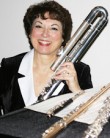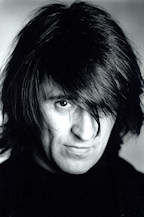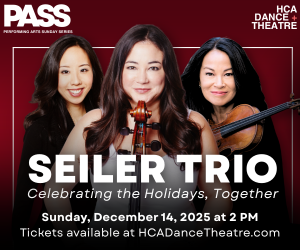The cities are Toronto and Los Angeles; the orchestras are the Niagara Symphony, the Scarborough Philharmonic, Sinfonia Toronto and the New American Orchestra; the flutist is Louise Di Tullio, and her nephew is Toronto composer and teacher, Ron Royer.
Let’s start with the flutist. You have probably never heard of Louise Di Tullio, but if you ever watch American movies you are almost sure to have heard her play. Since she began playing professionally in 1958 Ms. Di Tullio has been the flutist or principal flutist in at least 1200 films. She has played the music of all the great American film composers – Jerry Goldsmith, John Williams, Henry Mancini, David Rose, John Barry, Danny Elfman – the list goes on and on.
She was born into a family of musicians in Los Angeles, and grew up in a highly cultivated musical milieu. Her father and three uncles were all members of the Los Angeles Philharmonic’s string section as young men. Father, Joseph Di Tullio, and his brother-in-law Kurt Reher later became first stand partners in the cello section of the 20th Century Fox orchestra. Reher later returned to the L.A Philharmonic as the principal cellist.
In the 1940s when Louise was still a child, her father and uncles were instrumental figures in a series of concerts of contemporary music, “Evenings on the Roof,” on the roof deck of the home of concert pianist Francis Mullen Yates and her husband Pete Yates, which overlooked the city. The series became popular with a host of the century’s most prestigious composers who had come from Europe in the 1930s seeking refuge from Nazi persecution. They included Igor Stravinsky, Arnold Schoenberg, Erich Korngold, Darius Milhaud, Max Stein, Nadia Boulanger, Ernst Krenek, Sergei Rachmaninoff and a good many others. It was in this stimulating and nurturing environment that she grew up and at an early age began piano lessons, but at the age of eleven began playing the flute.
Her instruction on flute was highly unorthodox. Her first and primary teacher was her father, who was a cellist, not a flutist: “Dad was instrumental in keeping me on the straight and narrow. He helped me a great deal.” His methods were highly original, as when he taught her how to produce a vibrato. He simply demonstrated vibrato on the cello and asked her to do the same thing on the flute. This was so effective that none of the flutists with whom she later studied ever asked her to change the way she produced vibrato. In her teens she studied briefly with several flutist-teachers, one for only six months, but “I’ve never worked so hard in my life as when I studied with him,” and gained secure technique. Another introduced her to a lot of repertoire.
About the same time she, her sister Virginia and her father formed the Di Tullio Trio, which performed chamber music all over California and gave her a love of playing with others. Louise and Virginia would play their newest repertoire at family get-togethers, enabling her to practise in front of a very supportive but highly discerning audience.
In her late teens and early twenties she played in the Los Angeles Philharmonic and various other orchestras. In the early 1960s, the music contractor Phil Kahgan introduced her to Stravinsky, a meeting which resulted in her playing principal flute for the recordings of his music done in California under his supervision. Eventually she left the Los Angeles Philharmonic to pursue a free-lance career which allowed her the freedom to take advantage of the vast and varied musical opportunities in L.A. which included both classical performance and recording for films, TV and records.
This brings us to Louise’s nephew, the son of her pianist sister, Virginia, Ron Royer. Himself a studio musician in L.A., Ron’s marriage to clarinettist Kaye Powell brought him to Ontario in the late 1980s. He played cello as a TSO sub for a year, among other things, before a repetitive strain injury curtailed his ability to play. He became the string teacher at UTS and continued his education at the Faculty of Music at U of T, graduating in 1997 with a Ph.D. in composition. Since then he has maintained a multi-faceted career as a teacher, composer and conductor.
Back in the early 1980s Ron and his Aunt Louise both played in the first of our story’s four orchestras, The New American Orchestra was founded in 1979 by conductors, Jack Elliott and Allyn Ferguson, to perform contemporary American music. It was, according to Ron, an amazing orchestra and a really incredible experience to play in it, rubbing shoulders not only with the crème de la crème of Los Angeles musicians but also with leading composers who conducted works they had been commissioned to write for it. Louise, who was the principal flute, with Elliott’s blessing asked David Rose, one of the best and most prolific Hollywood composers of the time, to write a work for her to perform with the orchestra. He wrote Le Papillon, which she performed several times with The New American Orchestra as well as with the Boston Pops. The work, however, was never published and never recorded.
Fast forward to Toronto in late 2008.
Louise wanted to get the work out into the world so that it could take its place in the flute repertoire, be performed and receive the recognition it deserved. Family and friends had been urging her to make a CD. There was, of course, the question of what else should be on such a recording. All the mainstream flute repertoire has been recorded many times over, but what hadn’t been recorded, and which had been such a central part of her life, were flute solos from Hollywood soundtracks.
She talked to Ron (who had just recently been involved in another recording project, and also had just finished writing the score for the film “Gooby”) about the idea of making a CD which would include Le Papillon, concert arrangements of some of her favourite movie themes, and something for all four flutes that she frequently is called upon to play in recording sessions: the “normal” flute, the piccolo, the alto, and the bass flute. Ron agreed to write arrangements of the film music, to re-orchestrate the Le Papillon for chamber orchestra (thereby making it possible for more organizations to do), and to write a new work – a suite in which each of the four movements would be played on a different flute.
The other indispensable person on the team would be producer, musicologist, composer and author, Jeannie Pool, who, with myriad contacts in the film and music industries, has been able to arrange the rights to perform and record the music.
This is where the other three orchestras come in. Ron is composer-in-residence of Sinfonia Toronto, interim conductor of the Scarborough Philharmonic, and has had a long association with the Niagara Symphony, which has commissioned his work and in which his wife, Kaye, plays clarinet.
What has been arranged is that Louise and Jeannie are coming to Toronto in mid February. Louise will play two concerts with the Niagara Symphony on February 21 and 22, before which Ron, Jeannie and Louise will give a pre-concert talk, and in which Ron will guest conduct the premiere of his piece, Short Stories for Flutes, and his arrangement of Le Papillon. The following Saturday, February 28, Ron will conduct the Scarborough Philharmonic in a similar program, and the next day, Sunday March 1, he will conduct Sinfonia Toronto, again in a similar program at Hart House.
On Monday and Tuesday, Louise and Sinfonia Toronto with Ron conducting will record the whole program at Kick Audio’s studio with engineer, Jeff Wolpert. The CD will be released by Cambria Master Recordings in California.
Thus Louise De Tullio, probably the flutist whose playing has been heard by more people than any other flutist ever, will give the world a truly unique recording of solo flute music that has never been recorded beyond the soundtracks that brought it into being, and will provide a memento of her long and fascinating musical journey. Fortunately for us, and thanks in large part to Ron Royer, we will have the opportunity to experience Ms. Di Tullio’s remarkable playing at these four concerts he has arranged.
|
Two More Visiting Artists There are two other visitors I’d like to mention here. First, Russian viola virtuoso, Yuri Bashmet, and the Moscow Soloists will perform at Roy Thomson Hall on February 17. Led by the charismatic Bashmet, the Moscow Soloists is comprised of exceptional young musicians nominated by professors at the Moscow Conservatory as the very best of their generation. Formed in 1992 it is one of the world’s most highly acclaimed chamber ensembles, and has thrilled audiences in Moscow, Athens, London, Amsterdam and Paris. Their program will include Grieg’s Holberg Suite, Stravinsky’s Apollo Concerto in D (for which the Moscow Soloists won the 2008 Grammy Award in the Best Small Ensemble Performance category), Tchaikovsky’s Souvenir de Florence and Bruch’s Kol Nidrei and Paganini’s Concertino in A Minor, in both of which Bashmet will be the viola soloist. |
|
Just two days later on February 19 at Glenn Gould Studio American pianist Ivan Ilic will make his début Canadian recital with a programme that includes new works by Canadian composers as well as six of Debussy’s Préludes, of which he has just released a CD (reviewed in this issue of the magazine on page 56). In addition, part of the program will be repertoire for the left hand alone, works which according to Ilic are rarely played but are enriching for the performer.
Canadian composer, Brian Current, whose composition, Banjo/Continuum, is being premiered at the recital, will give a pre-concert chat at 7:30.





